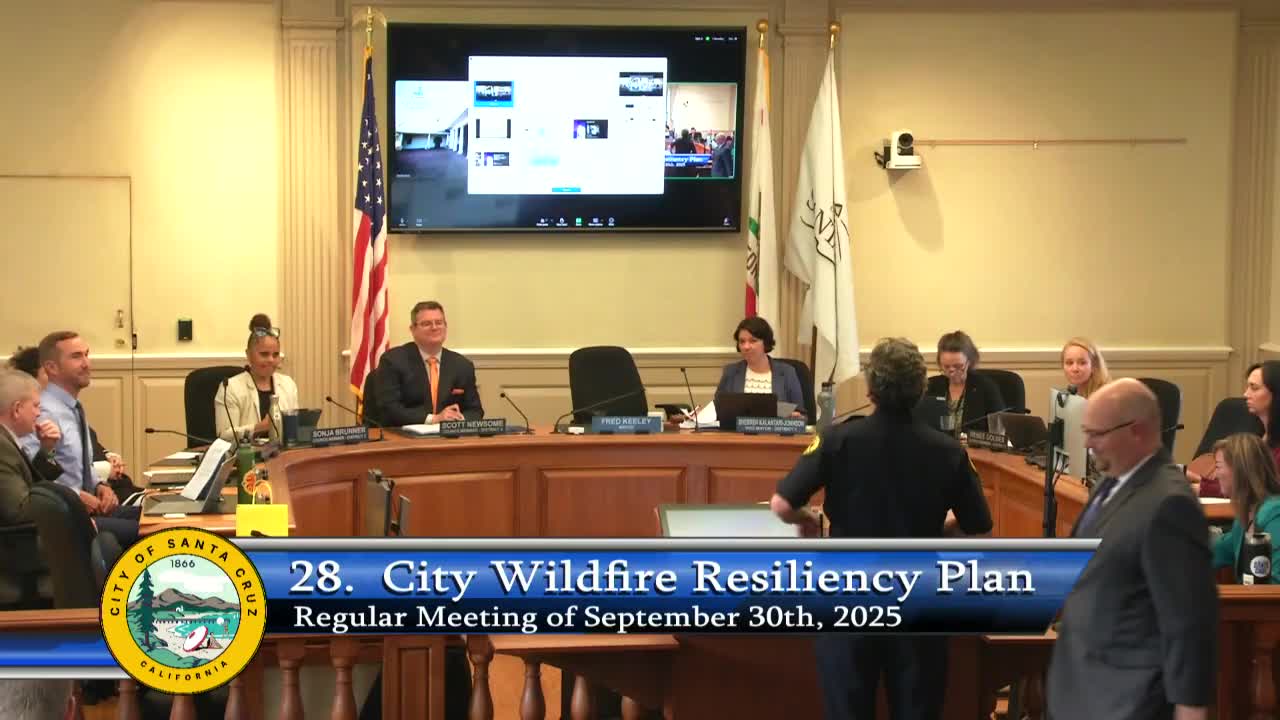Fire department unveils citywide wildfire resiliency plan mapping priority treatment zones and permitting strategy
October 04, 2025 | Santa Cruz County, California
This article was created by AI summarizing key points discussed. AI makes mistakes, so for full details and context, please refer to the video of the full meeting. Please report any errors so we can fix them. Report an error »

City staff and consultant ARC Forestry presented a Wildfire Resiliency Plan to the Santa Cruz City Council on Sept. 30 that identifies priority treatment zones across city open spaces and critical infrastructure, outlines permitting approaches and describes funding and collaborative options for implementation. The presentation was informational; no council vote was required.
Fire Division Chief/consultant introductions identified a multiagency technical working group that included city fire, parks, water and public-works staff. ARC Forestry principal Steve Otten described six major topics the plan covers: scope of work across Santa Cruz Mountains lands, priority treatment zones selected for initial work, the permitting strategy (including short-term governor’s suspensions and longer-term California Vegetation Treatment Program permitting funded in part by the Coastal Conservancy), treatment methods (manual, mechanized, prescribed herbivory and prescribed fire), and funding/collaboration approaches.
Nut graf: The plan maps prioritized work around critical facilities — notably the emergency operations center, water tanks and pump stations, and open-space preserves such as Pogonip and DeLaveaga — and recommends permits and funding strategies to enable treatments that reduce ignition risk and improve forest health.
ARC Forestry estimated initial treatment costs across priority zones could range from approximately $500,000 to $1.2 million depending on method (manual versus mechanized) and site constraints; staff noted budgetary ranges depend on available grants and ongoing funding streams. The consultant also described working with partners such as the Resource Conservation District and the Coastal Conservancy to pursue grants, including a wildfire prevention grant and a statewide vegetation-treatment CEQA permit supported by the Coastal Conservancy.
Public questions at the meeting included species-specific concerns such as eucalyptus removal and potential habitat impacts (for example, monarch butterfly habitat). Presenters said work would be site-specific, that eucalyptus removals are not a blanket strategy, and that the city would coordinate with specialists (for example, Xerces Society) and follow CEQA-required biological surveys where relevant.
Ending: The finalized plan (approximately 184 pages) is posted on the fire department website; staff and the consulting team said they will pursue grants and the permits described and bring funded projects forward for implementation.
Fire Division Chief/consultant introductions identified a multiagency technical working group that included city fire, parks, water and public-works staff. ARC Forestry principal Steve Otten described six major topics the plan covers: scope of work across Santa Cruz Mountains lands, priority treatment zones selected for initial work, the permitting strategy (including short-term governor’s suspensions and longer-term California Vegetation Treatment Program permitting funded in part by the Coastal Conservancy), treatment methods (manual, mechanized, prescribed herbivory and prescribed fire), and funding/collaboration approaches.
Nut graf: The plan maps prioritized work around critical facilities — notably the emergency operations center, water tanks and pump stations, and open-space preserves such as Pogonip and DeLaveaga — and recommends permits and funding strategies to enable treatments that reduce ignition risk and improve forest health.
ARC Forestry estimated initial treatment costs across priority zones could range from approximately $500,000 to $1.2 million depending on method (manual versus mechanized) and site constraints; staff noted budgetary ranges depend on available grants and ongoing funding streams. The consultant also described working with partners such as the Resource Conservation District and the Coastal Conservancy to pursue grants, including a wildfire prevention grant and a statewide vegetation-treatment CEQA permit supported by the Coastal Conservancy.
Public questions at the meeting included species-specific concerns such as eucalyptus removal and potential habitat impacts (for example, monarch butterfly habitat). Presenters said work would be site-specific, that eucalyptus removals are not a blanket strategy, and that the city would coordinate with specialists (for example, Xerces Society) and follow CEQA-required biological surveys where relevant.
Ending: The finalized plan (approximately 184 pages) is posted on the fire department website; staff and the consulting team said they will pursue grants and the permits described and bring funded projects forward for implementation.
View full meeting
This article is based on a recent meeting—watch the full video and explore the complete transcript for deeper insights into the discussion.
View full meeting
